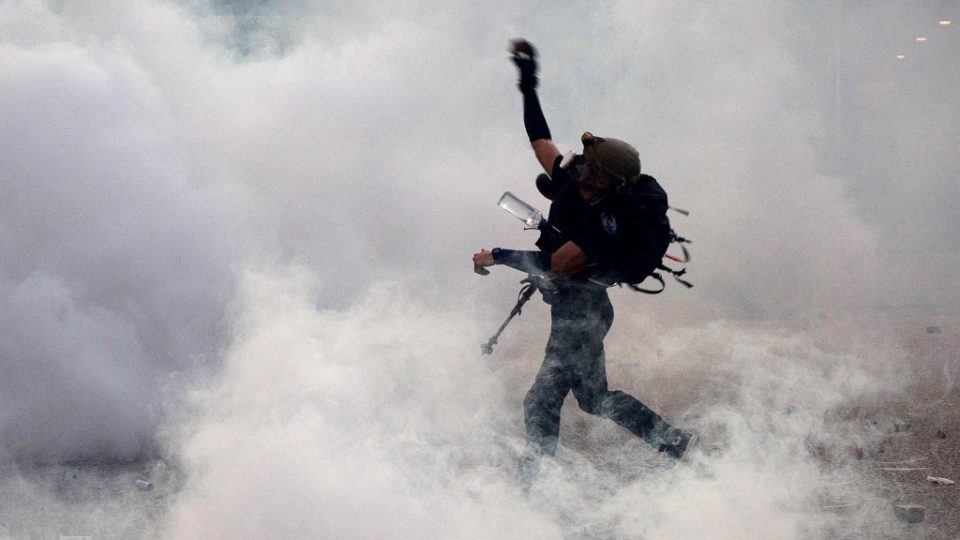Hong Kong riot police clashed Monday with pro-democracy protesters for a third straight day, as the city’s leader warned the global financial hub was nearing a “very dangerous situation” and a rare strike caused transport chaos.
Clouds of tear gas billowed across multiple locations on Monday as the city buckled under a general strike, which protesters pushed to emphasize they still had broad public support following two months of increasingly violent unrest.
In a rare public appearance since the crisis began, chief executive Carrie Lam warned protesters she would not cave to their demands.
“[They] have seriously undermined Hong Kong’s law and order and are pushing our city, the city that we all love and many of us helped to build, to the verge of a very dangerous situation,” Lam said.
She later referenced chants by protesters for a “revolution,” describing this as a challenge to the “one country, two systems” framework under which Hong Kong has been ruled since it returned from British to Chinese rule in 1997.
https://twitter.com/sumlokkei/status/1158378887765618688
“I dare say they are trying to destroy Hong Kong,” said Lam, who was appointed by a pro-Beijing committee.
China’s cabinet-level State Council said it planned to hold a press conference on Tuesday.
Lam spoke on a day that saw widespread civil disobedience across the city.
Activists descended on subway stations during morning rush hour, deliberately keeping open doors to stop trains departing and paralyzing large parts of a network that millions of people use daily.
They later held simultaneous rallies at seven locations and besieged multiple police stations, stretching the resources of a force that has become a lightning rod for public anger.
tear gas fired again in #wongtaisin. when has firing tear gas become a norm in protests? do police officers still file reports for every tear gas, rubber bullet and sponge bullet they have fired? #hongkongprotests #hongkong pic.twitter.com/NZ8tHXxWwB
— Fion Li (@fion_li) August 5, 2019
Tear gas was fired in at least eight separate locations across the city, making Monday’s clashes the most widespread so far.
The most sustained clashes occurred outside the city’s parliament — where protesters used giant slingshots to launch bricks — and in the working-class district of Wong Tai Sin.
Though police had issued a no-objection letter for a rally in Tamar Park next to parliament, pro-democracy protesters had soon occupied the adjacent Harcourt Road, with police raining tear gas on them, at times from the roofs of government buildings.
The protestors could be seen moving and crouching in formation, guarded by makeshift wooden shields at the front. But they were soon engulfed by a cloud of tear gas despite their quick efforts to extinguish and throw away the canisters.
“We have tried so many methods to get the government to listen and change but none of them have worked so far. I don’t know what else we can do to face up to such a cold-blooded government,” said a designer, who gave his name as Wing, at the Tamar Park rally.
“The strike has had a massive impact so far and I just don’t believe Hongkongers would abandon their work for trivial reasons,” another designer, who gave his name as Austin, said.
In the evening, a group of men armed with long sticks, clashed with protesters in North Point, a neighborhood where many Chinese migrants live and which is known for its strong Beijing ties.
They chased and beat protesters, who threw traffic cones and barricades in return.
Similar clashes broke out elsewhere in the city as the night wore on.
Protesters unbowed
In a briefing that highlighted the longevity of the protests, police said they had fired more than 1,000 rounds of tear gas and 160 rubber bullets since rallies began on June 9, with 420 people arrested and 139 officers injured so far.
But the protesters remain unbowed.
“Support for the political strike today seems strong and it has been bolstered further by the escalating violence between the police and protesters,” political analyst Dixon Wong told AFP.
The strike — a rare occurrence in the finance hub where unions traditionally have little sway — hit the vital aviation sector.
More than 160 flights at the city’s airport, one of the world’s busiest, were listed as cancelled on Monday. Many were with Cathay Pacific, Hong Kong’s flag carrier.
The airline did not give a reason for the cancellations, but its flight attendants union confirmed some of its members had walked out.
Some key roads were also blocked and many shops across the city were shuttered, including big-name fashion outlets in the central commercial district.
The strike led to some scuffles between angry commuters and protesters at crowded subway stations.
One video, verified by AFP, showed a car smashing its way through a protester roadblock in the northern town of Yuen Long.
Another showed a taxi ramming protesters who hurled projectiles.
Surge in violence
But while some locals were angered by the disruptions, others said they supported the action.
“As long as the government doesn’t respond then for sure the movement will escalate,” a civil servant, who gave his surname as Leung, told AFP as he tried to make his way to work.
The past fortnight has seen a surge in violence from both sides, with police repeatedly firing rubber bullets and tear gas to disperse increasingly hostile projectile-throwing crowds.
A week ago a group of men suspected to be linked to triads — Hong Kong’s notorious gangsters — also attacked demonstrators, putting 45 people in hospital.
Dozens of protesters have been charged with rioting, which carries a jail term of 10 years.
The protests were triggered by opposition to a planned law that would have allowed extraditions to mainland China, but have evolved into a wider movement for democratic reform and a halt to eroding freedoms.




